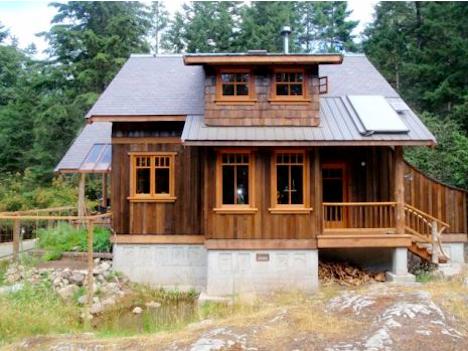Build Your 100-mile Dream Home

You've heard of the locavore diet: only eating what's available within 100 miles of you. Now there's loca-arch (yeah, we're still looking for a catchy name), a movement that supports new building with only the materials available in your immediate environment. Want Italian marble countertops? Unless there's a quarry nearby that can provide something similar, you're going to have to either find an alternative or move to Italy.
To promote the idea, the Architecture Foundation of British Columbia launched an international competition to design a 1,200-square-foot, four-person home that uses only materials made or recycled within 100 miles of Vancouver (much like the 100-mile locavore diet challenge, also born in Vancouver). While everyone's in a tizzy over getting LEED certified, 'locavore architecture' is a much more sustainable approach.According to GOOD, "although a large percentage of the world's population live in homes made from local materials, the idea of intentionally setting geographic restraints on modern building materials is a relatively novel idea. One example of an existing 100-mile house is the home built by naturalist and writer Briony Penn in British Columbia, just across the Strait of Georgia from Vancouver. With help from builder Michael Dragland, she applied the principles of the diet to the 1,150-square-foot home she recently built on Salt Spring Island."
Penn said that while the experience of building the house was fun and allowed her to engage with her community, it wasn't always easy. "The most difficult things to find within 100 miles were insulation and light fixtures," she said. She had many items custom-made, and, at the end of the day, spent $300,000—much more than she would have on a traditional house. Still, she has no regrets. "If you just say, 'Here's my budget,' and then you build smaller, but sweeter, it's just a simple case of changing your parameters and values. Instead of trying to push for maximum space at the cheapest price, you push for maximum quality and you settle for less space, and honestly, you don't miss the space."
Ready to go back to basics and enter the competition to build your own 100-mile home? Submissions are due by the end of April. The first prize winner gets $5,000, which may not buy enough local timber for the whole frame, but if you're the kind of person who enters a contest like this, my guess is money is not a major motivator. Or, sit this round out and see how Penn built her 100-mile dream house.
-
oFavorite This
-
Q5Comment
K
{Welcome
Create a Core77 Account
Already have an account? Sign In
By creating a Core77 account you confirm that you accept the Terms of Use
K
Reset Password
Please enter your email and we will send an email to reset your password.



Comments
Earthen buildings are literally as cheap as dirt, can usually be built with the material right under your feet, allow for very organic and sculptural forms, don't release VOCs, have a ridiculous amount of thermal mass, usually prove extremely durable, are reasonably quick to erect, and when the building has finally outlived its usefulness, it can be torn down back into a mound of dirt.
What about developing right in town if we're really concerned with saving resources?
One could well make a case that one or two well-run, efficient plants located near their source materials producing a specific item are better than dozens or hundreds of distributed, less-efficient ones.
Especially when you consider that the raw materials for manufacturing something "locally" mean that those raw materials were shipped to hundreds of distinct locations, as opposed to just a few.
Pound-for-pound, finished goods are easier to ship than raw materials any day.